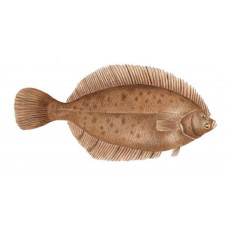Latin name
Pseudopleuronectes americanus
Other names
Flounder, lemon sole, sole, blackback, blueback, black flounder, dab, mud dab, flatfish, Georges Bank flounder; French: plie rouge; Italian: sogliola limanda; Spanish: mendo limon
Identification
The body is oval and flat with a tiny mouth. The color varies from reddish-brown to dark brown with small black spots. The underside is whitish, sometimes brown, with a blue tint around the edges. The caudal fin is slightly rounded. The winter flounder differs from the similar yellowtail flounder in its straight lateral line, lack of an arc over the pectoral fin, thicker body, and widely spaced eyes. The ocular side of the body and the upper part of the head, including the midsole waist, are covered with fine, dense-skinned ctenoid scales. The scales on the blind side of the body are cycloidal.
Distribution
Atlantic coast of North America - from Labrador in the north to North Carolina and Georgia in the south. It is most abundant in the south of the Grand Banks of Newfoundland, on the shoals off the coast of Nova Scotia, and in St. Mary and Fundy Bays. Still, common from the Chesapeake Bay to the Gulf of St. Lawrence. Individuals are found as far south as Georgia and as far north as Labrador.
Habitat
Winter flounder are shore-dwelling in estuaries and coastal areas of the ocean. In the mid-Atlantic, they stay near shore from January through April. Shallow fish live in shallow water, larger fish enter water no deeper than a foot. They live in depths of at least 400 feet. Prefer sandy-silty bottoms, also found on sand, clay, fine gravel, and hard bottoms at sea. Prefers waters with a temperature of 14-15 °C and salinity of at least 15%.
Size
Spawning takes place in shallow water on the sandy bottom from January through May. Winter flounder eggs clump together and sink to the bottom, where they hatch in about 16 days, depending on water temperature. In the fall, these fish move from deep water to shallow water and then return to the sea in the spring. Spawning occurs at a water temperature of 1-10 °C, the peak of spawning at 2-5 °C. Maximum fecundity is over 3 million eggs, with an average of about 500,000 eggs.
Food and feeding habits
Most winter flounder weigh from 1 to 11⁄2 pounds, averaging less than a foot in length, can grow to 8 pounds and 2 feet. The world record for all-tackle fishing is 7 pounds. Large fish are sometimes called "sea flounders" to distinguish them from smaller bay fish. Growth rates vary depending on the habitat area.
Life history and Behavior
Once on the soft bottom, it burrows in as far as its eyes can see, waiting to attack its prey. Because of its small mouth, its diet includes only small food such as sea worms, small crustaceans and small shell animals such as mollusks and snails. Before spawning, the winter flounder stops eating.
Reproduction
Eggs are spherical, 0.7-1.0 mm in diameter, 0.8 mm on average, bent, sticky, usually attached to algae, forming small clusters. Their development at water temperatures of 2.7-3.3 °C takes 15-18 days, and at 4-5 °C - on average 26 days. Fore larvae are pelagic, hatching at 2.3 to 3.5 mm in length; the yolk sac is dissolved at about 5.0 mm in length. Larvae sink to the bottom before completing the metamorphosis stage at 6 to 9 mm in length.
| Classification | |
| Phylum | Chordata |
| Class | Actinopterygii |
| Squad | Pleuronectiformes |
| Family | Pleuronectidae |
| Genus | Pseudopleuronectes |
| Species | P. americanus |
| Features | |
| Conservation status | Least Concern |
| Habitat | bottom |
| Life span, years | 15 |
| Maximum body weight, kg | 3.6 |
| Maximum length, cm | 70 |
| Sailing speed, m/s | No information |
| Threat to people | Edible |
| Way of eating | Bentophage |



